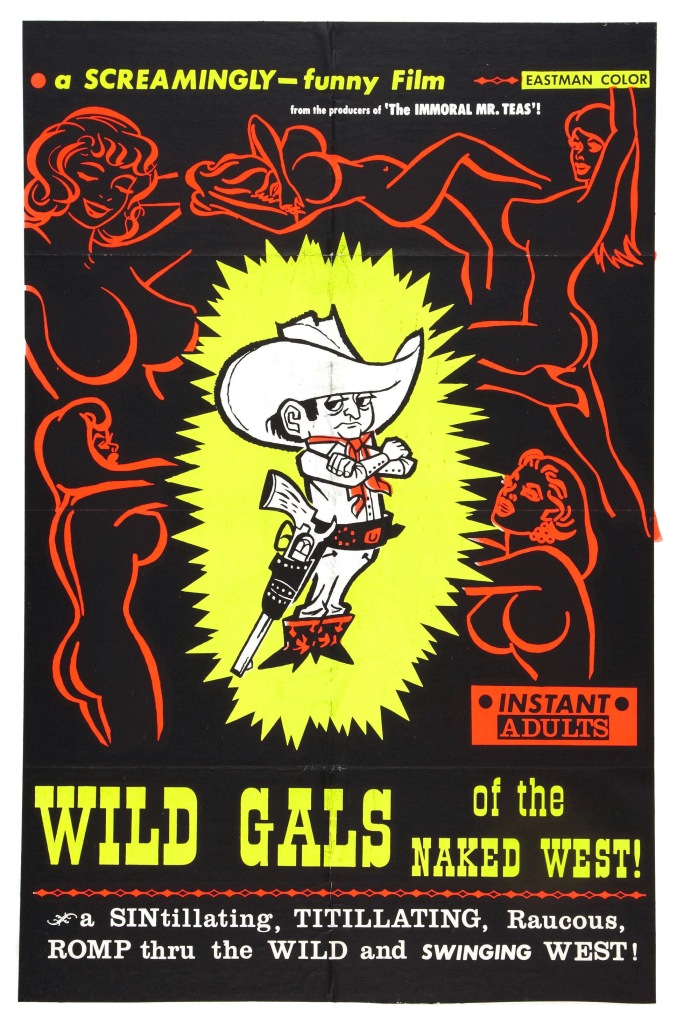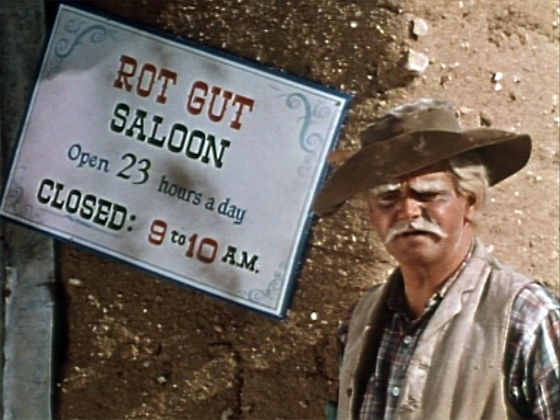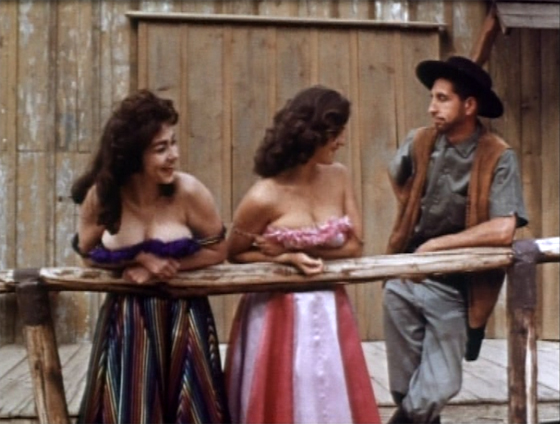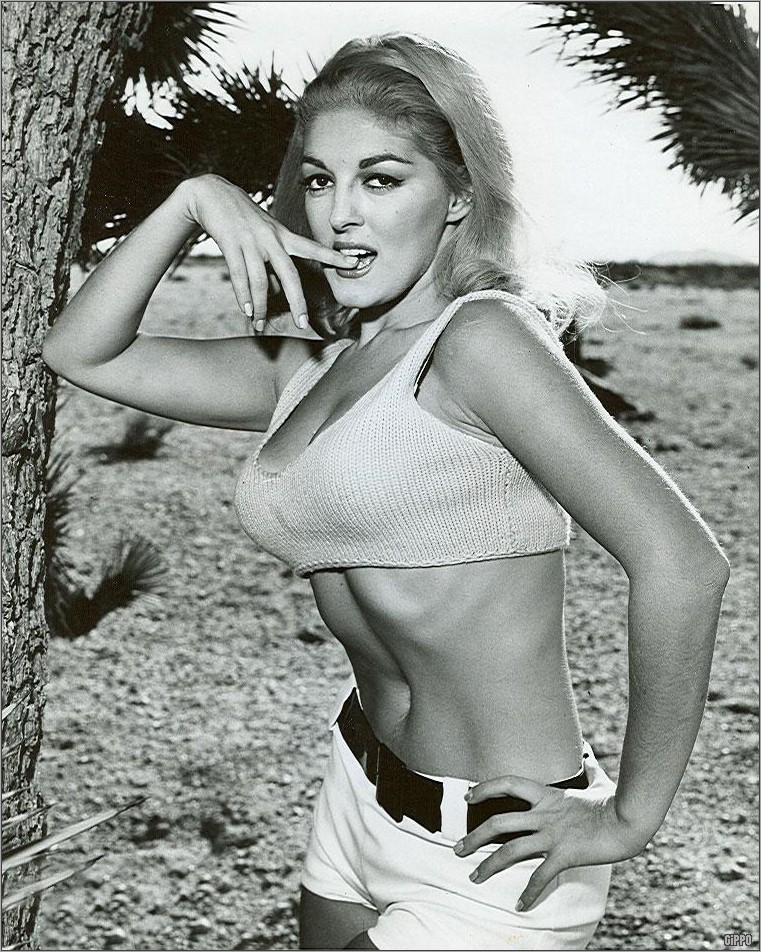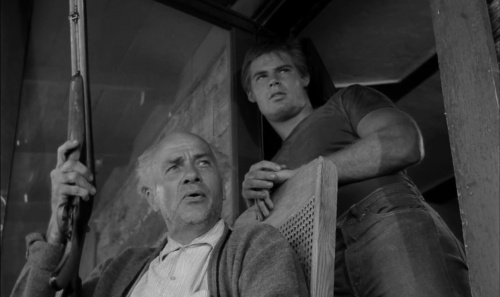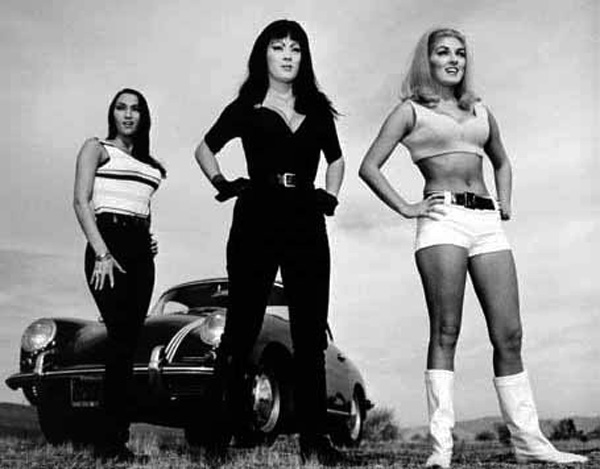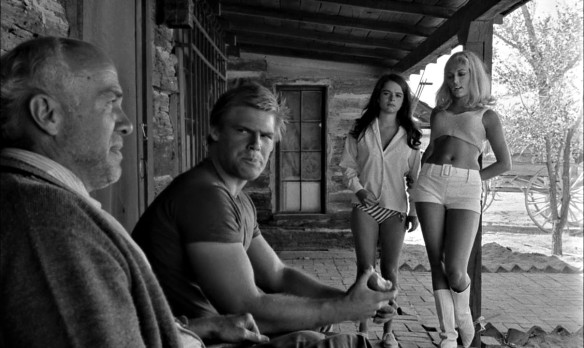Russ Meyer has a true ebb and flow when it came to his nudie cuties. For every advance forward, there was a trepidation followed by a slight retreat. Eve and the Handyman improved on The Immoral Mr. Teas in a fundamental way by ditching the multitude of women in favor of one central female character. Erotica, Eve and the Handyman’s follow-up, cycled backwards in terms of subject matter but found some fresh and creative photographic advances that would serve him well throughout the remainder of his career.
Wild Gals of the Naked West was Meyer’s next film in his nudie cutie cycle and his penultimate effort in the subgenre (excluding 1964’s Europe in the Raw, a film better classified as a nudie travelogue). Moving back towards the strengths of Eve and the Handyman while also beefing up the comedic bits strung along the length of the film, Wild Gals of the Naked West is probably Meyer’s most successful blend of his type of raucous comedy in the service of a mostly plotless phantasmagoria of tits and ass.
From the jump, one of the clearest differences between Wild Gals and the Naked West and the nudie cuties that came before it is the absolutely gorgeous photography that populates the opening narration. Beginning with a brew of stunning horizons and landscapes interspersed with quickly-cut dutch angles, Meyer shows the high level of his talent by taking us out of the muddy cricks and swimming pools of his previous work and expanding his visual world outward to capture some truly painterly compositions of the western vistas. Meyer cleverly maneuvers around the film’s microbudget by utilizing symbols and western iconography to stand in for the lack of action; the first-person perspective used in the ghost towns and broken down structures feel like the spirits of the past that are somehow still alive.
In fact, so beautiful is the opening to the film that it finally draws attention to one of the biggest elephants in the room when it comes to Meyer’s work; in short, this is the first film in his filmography where watching it creates a general sadness when you realize that, due to Meyer’s lack of care in the preservation of his own work either during his natural life or in a testamentary capacity, these movies will likely never get upgraded beyond their current full-frame video scans and will eventually be lost to time due to almost-certain deterioration of the original material. It seems unthinkable that this is truly the case but… well… there’s a reason Martin Scorsese fights so hard for film preservation.
Not quite a series of episodes as his previous three features, Wild Gals of the Naked West tries for something that resembles a plot. Sure, it’s simple and padded out by copious post-credit narration before the wraparound framing device involving a storyteller is introduced, but the bedrock of many of Meyer’s themes he’d take with him into his Gothic period begin to sprout and take form just as some of his more sophisticated framing devices began to pop up in the previous year’s Erotica. In Wild Gals of the Naked West, we are spun a tale by a fourth wall-demolishing old man (Jack Moran), still living among the ghosts of a dilapidated western town that fell into rack and ruin due to too much goodness. But it wasn’t always like that, according to our faithful raconteur. Hell, once upon a time, the town was so marinated in sin that they dared not even give the location a proper name.
And it is here is where the basic story comes into play as the film functions as a before and after, the tipping element being the introduction of a do-gooder Stranger (Sammy Gilbert) who descends on the town with designs on pulling a reverse High Plains Drifter by painting the town virginal white. Set up in the front half with wanton hedonism at a breakneck pace only to be knocked off in the back half as The Stranger executes his righteous morality, Wild Gals of the Naked West unwittingly figured a way for Meyer to indulge in as much bawdy sexuality as he wished as long as he laced it all with a light dose of trite morality. Given how much play both the dopey, square-jawed hero and the tongue-in-cheek pontifications on freedom, ethics, and what-have-you factored into so much of his later work, it’s not inappropriate to see Wild Gals of the Naked West as one of Meyer’s most substantially consequential nudie cuties; the yang to Eve and the Handyman’s yin.
The film is additionally blessed by being well-acted and the imagery is wildly modernistic in its approach, both of which cause the film to really pop. And even if the film’s numerous running gags seem limited and finally run out of gas, the film never drags and it makes a real effort to rise above its throwaway title and to try and wring something a little more creative out of the nudie cutie than what was the standard, mediocre fare at the time. There is a pure visual joy in juxtaposing the authentic exteriors with the Chuck Jones-adjacent interiors where painted backgrounds resembles the angular impossibilities in Jones’s background cel art. Again, this lays some early groundwork for Meyer to work with later during his “Bustoon” period of the seventies which would be chock full of Looney Tunes inspired action replete with fully animated buildings that rock and undulate to keep up with the action happening inside of them.
And there’s more in Wild Gals of the Naked West that speaks to Meyer’s actual thematic concerns that would continue to pop up throughout his work. The masculine hero being a sexual impotent, the celebration of just a splash of hedonism in a balanced life, and the dismissal of male authority figures such as members of law enforcement (Meyer’s old man, a cop, walked out on the family when he was a child) and religious leaders are all rolled out in this seemingly innocuous piece of fluff.
With just one more nudie cutie and a trip to Europe to go before he began his personal narrative films that made up the Gothic portion of his career, Russ Meyer was looking more and more like a talent ready to break away from the confines of his own creation and into something a little more substantial. Wild Gals of the Naked West was a pit stop to that goal but, in terms of Meyer’s cinematic education, it ended up being a more substantial one than anyone thought it would be.
(C) Copyright 2022, Patrick Crain
Patrick Crain is a freelance writer and film programmer for the Oklahoma Film Society. He spends his days in semi-retirement by pacing around his home in Oklahoma City, watching movies, writing about them, and then pouring wine for both he and his wife at around 4:30CST. His scribblings about the motion pictures can be found at www.apollotwin.com. He can be found on Instagram here and on Twitter here. He is also on Letterboxd.

